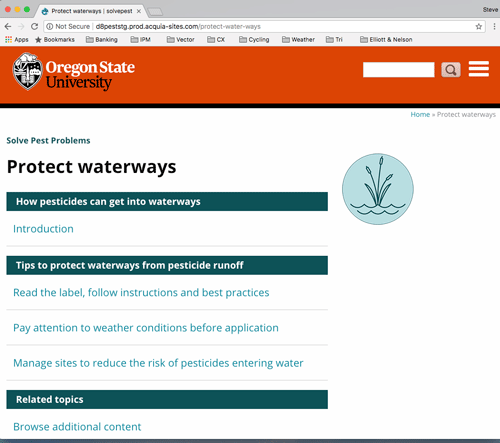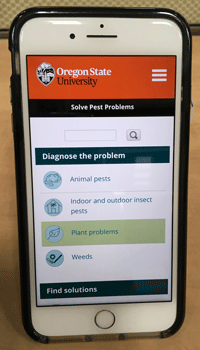Developing IPM Resources for Non-Ag Audiences
While burglarizing the three bears’ home, Goldilocks repeatedly found that too much is too much, and too little is not enough.
That idea is driving a new effort in Oregon to provide the just right amount of pest and pest-management information to homeowners, landscapers and public agencies.
“There was a gap in information specifically for non-agricultural audiences,” explained Weston Miller, an urban horticulturist with Oregon State University. “The Pacific Northwest Pest Management handbooks have too much information for regular folks, and their non-chemical management recommendations are geared for an agricultural scale, not a landscape scale.”
So with start-up funding from a variety of state and Portland-area sources, Miller and his team are developing a new phone-friendly, photo-forward website to provide information about pests and integrated pest management solutions for Oregonians. Planned sections include:
- Diagnose the problem – information to help people identify insect and animal pests, weeds and plant problems.
- Find solutions – information about non-chemical solutions, chemical treatments, and a guide to reading pesticide labels. There’s even an “I don’t know where to start” section that provides a primer on pest management.
- Recommended practices – to protect waterways and pollinators, and to safely store, transport and dispose of pesticides.
- Specific information on high-priority invasive weeds and insects.
- Spanish-language pages covering all the above.
 “We’re in the proof-of-concept stage of the project,” Miller said. “We have about 100 pages of content we’ll be circulating in July to get feedback and suggestions.”
“We’re in the proof-of-concept stage of the project,” Miller said. “We have about 100 pages of content we’ll be circulating in July to get feedback and suggestions.”
Because the information is on a responsive website, people will be able to find the information they need and access it on a computer, tablet or smartphone. It won’t be an app users have to download to their devices.
“From the user testing we’ve done so far, people are excited,” he said. “The trick has been to keep people from being overwhelmed by keeping things as condensed as possible.”
The website development is being advised by a community-based steering committee and one important goal for the project is to bring IPM information to underserved audiences including Spanish-speakers and communities of color.
Some key questions haven’t been answered yet. One is the scope of the site. Will it be Oregon specific or encompass the whole Pacific Northwest? It’s being built on an open-source web-development platform, so it could be adapted for other areas if there’s interest.
“Part of our vision all along was that it would be replicable,” said advisory committee member Carl Grimm, the senior solid waste planner with the Metro regional governance agency. “There could be a PestProblemsOregon.org site, and a PestProblemsSomeOtherState.org site, for instance, for other states that were interested.”
Key question number two is funding. Miller estimates that building out the site fully will take more than $3.5 million, plus ongoing costs for maintenance and updating, and where that money would come from hasn’t been identified yet. He envisions a state-level investment and commitment.
“In the scheme of the state budget, it’s not a lot of money and it addresses a number of very important areas, including water quality and pollinator protection,” he said. “I think we can make a pretty good case for the project.”
If funded and fully developed, Miller and his team are also planning extensive outreach, engagement and evaluation efforts to promote the site and measure its impacts. He thinks the state’s Master Gardeners will be ideal ambassadors to introduce Oregonians to the site and its information.
“There are 2,500 Master Gardeners in Oregon,” he said. “We have a built-in way to market this out to the public.”